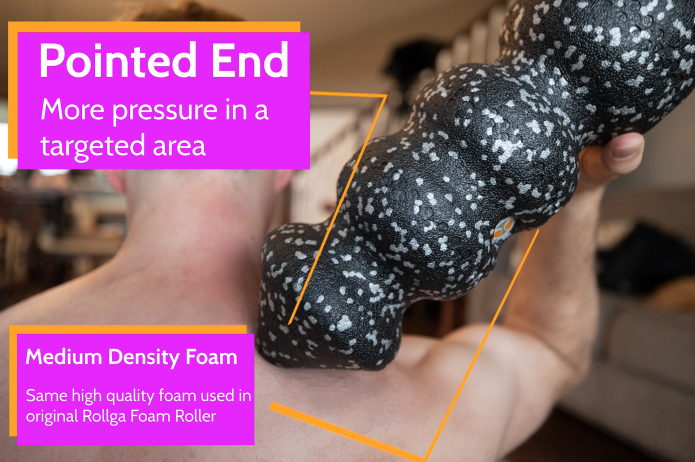
The rotator cuff is a crucial group of muscles and tendons that stabilize the shoulder joint, allowing for a wide range of motion. Unfortunately, injuries to the rotator cuff, such as tears, are relatively common, particularly among athletes and individuals engaged in repetitive overhead activities. Detecting the warning signs of a rotator cuff tear is essential for prompt diagnosis and appropriate treatment. In this article, we will discuss four common indicators of a rotator cuff tear and explore the potential benefits of Rollga as a treatment method.

- Persistent Shoulder Pain:
One of the primary warning signs of a rotator cuff tear is persistent shoulder pain. Individuals with a tear often experience a dull ache deep within the shoulder, which may worsen during specific movements, such as reaching overhead or lifting heavy objects. The pain can be constant or intermittent but tends to worsen over time if left untreated. If you notice ongoing discomfort in your shoulder, it's important to pay attention to other symptoms as well.
- Weakness and Limited Range of Motion:
A rotator cuff tear can lead to weakness and a noticeable reduction in the range of motion of the affected shoulder. You may find it challenging to lift objects, perform daily tasks that involve reaching or carrying, or even raise your arm above shoulder level. The weakened muscles and tendons can significantly impact your ability to engage in sports, exercise, or even complete basic activities of daily living.
- Nighttime Discomfort:
Another warning sign of a rotator cuff tear is pain and discomfort at night, particularly when lying on the affected shoulder. The pressure exerted on the torn tendon or muscle can cause increased pain, which can disrupt your sleep and overall quality of life. If you consistently experience shoulder pain that interferes with your ability to get a good night's sleep, it's crucial to consult a healthcare professional.
- Clicking or Popping Sensation:
A clicking or popping sensation in the shoulder joint can indicate a rotator cuff tear. This sensation may occur during certain movements or even when at rest. It's important to note that not all cases of clicking or popping in the shoulder are indicative of a tear, but when combined with other symptoms, it is worth investigating further.
Rollga as a Treatment Method:
While early diagnosis and appropriate medical intervention are crucial for the management of rotator cuff tears, certain treatment methods can be used in conjunction with medical care to promote healing and recovery. One such method is the use of Rollga.
Rollga is a unique foam roller designed specifically to target trigger points, tight muscles, and promote fascial release. Its patented shape and surface pattern help provide a gentle, yet effective, massage to the affected muscles around the shoulder joint. By rolling on the Rollga, you can enhance blood circulation, reduce muscle tension, and potentially alleviate some of the pain and discomfort associated with a rotator cuff tear.
Recognizing the warning signs of a rotator cuff tear is crucial for timely diagnosis and appropriate treatment. Persistent shoulder pain, weakness, limited range of motion, nighttime discomfort, and clicking or popping sensations are key indicators that should not be ignored. While Rollga can offer potential benefits as a treatment method by promoting muscle relaxation and blood circulation, it is essential to seek professional medical advice and follow a comprehensive treatment plan for optimal recovery. Remember, early intervention can significantly improve outcomes and help you regain full shoulder function.
Upon consulting with a healthcare professional, they may recommend a combination of treatments for a rotator cuff tear, including physical therapy, medication, and possibly surgery for severe cases. Physical therapy exercises are often prescribed to strengthen the surrounding muscles, improve range of motion, and promote healing.
Rollga can complement these treatment methods by providing targeted self-massage and promoting muscle relaxation. By gently rolling the affected shoulder and surrounding muscles on the Rollga foam roller, you can help release tension, reduce inflammation, and enhance blood flow to the injured area. This can aid in the recovery process and alleviate some of the discomfort associated with a rotator cuff tear.
When using Rollga as part of your treatment plan, it is essential to follow the guidance of your healthcare professional or physical therapist. They can provide specific instructions on how to incorporate Rollga into your rehabilitation routine and ensure that you are using proper technique and intensity.
Additionally, it's important to remember that every individual's condition is unique, and what works for one person may not work for another. While Rollga can be a valuable tool, it is not a guaranteed solution for everyone. Adherence to a comprehensive treatment plan, including professional medical advice, physical therapy, and proper rest, is crucial for optimal healing.
In conclusion, recognizing the warning signs of a rotator cuff tear is vital for timely intervention. If you experience persistent shoulder pain, weakness, limited range of motion, nighttime discomfort, or clicking/popping sensations, it is important to consult with a healthcare professional for an accurate diagnosis. While Rollga can serve as a supportive treatment method by promoting muscle relaxation and improving blood circulation, it should be used in conjunction with professional medical advice and a comprehensive treatment plan. With proper care and guidance, you can increase the likelihood of a successful recovery and return to a pain-free, active lifestyle.
